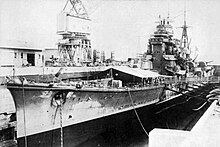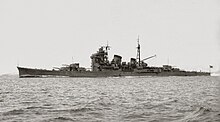Japanese cruiser Ashigara
 Heavy cruiser Ashigara photographed visiting a port in Germany, 1937
| |
| History | |
|---|---|
| Name | Ashigara |
| Namesake | Mount Ashigara |
| Ordered | 1924 |
| Builder | Kawasaki Shipyards, Kobe, Japan |
| Laid down | 11 April 1925 |
| Launched | 22 April 1928 |
| Commissioned | 20 August 1929 |
| Fate | Sunk by HMS Trenchant in Bangka Strait, 8 June 1945 |
| General characteristics | |
| Class and type | Myōkō-class cruiser |
| Displacement |
|
| Length | 203.76 m (668 ft 6 in) |
| Beam |
|
| Draft |
|
| Propulsion |
|
| Speed | |
| Range | 7,000 nmi (13,000 km) at 14 kn (16 mph; 26 km/h) |
| Complement | 920–970 |
| Armament |
|
| Aircraft carried | 3 |
| Aviation facilities | 1x aircraft catapult |
| Service record | |
| Part of: |
|
| Operations: |
|
Ashigara (足柄) was the final vessel of the four-member Myōkō class of heavy cruisers of the Imperial Japanese Navy, which were active in World War II.[2] The other ships of the class were Nachi, Myōkō, and Haguro.[3] Ashigara was named after Mount Ashigara on the border of Kanagawa and Shizuoka Prefectures.
Background
Ashigara was approved under the 1922 Fleet Modernization Program as one of the first heavy cruisers to be built by Japan within the design constraints imposed by the Washington Naval Treaty, and was one of the first of the "10,000 ton" cruisers built by any nation.[4] Naval architect Vice admiral Yuzuru Hiraga was able to keep the design from becoming dangerously top-heavy in its early years by continually rejecting demands from the Imperial Japanese Navy General Staff for additional equipment to the upper decks. However, during modifications and rebuildings in the 1930s, the final displacement rose to 15,933 tons, well over the treaty limits.[5]
Design

The Myōkō class displaced 13,500 t (13,300 long tons), with a hull design based on an enlarged version of the Aoba-class cruiser. Ashigara was 203.8 metres (669 ft) long, with a beam of 19.5 metres (64 ft), draft of 6.36 metres (20.9 ft) and were capable of 35.5 knots (65.7 km/h; 40.9 mph).[5] Propulsion was by 12
Ashigara’s main battery was ten 20 cm/50 3rd Year Type naval guns, the heaviest armament of any heavy cruiser in the world at the time, mounted in five twin turrets.[5] Her secondary armament included eight 12.7 cm/40 Type 89 naval guns in four twin mounts on each side, and 12 Type 93 Long Lance torpedoes in four triple launchers positioned below the aircraft deck. Ashigara was also equipped with an aircraft catapult and carried up to three floatplanes for scouting purposes.[5]
Ashigara was laid down at the Kawasaki Shipyards in Kobe on 11 April 1925, launched and named on 22 April 1928, and was commissioned into the Imperial Japanese Navy on 20 August 1929.[3]
Ashigara was repeatedly modernized and upgraded throughout her career in order to counter the growing threat of air strikes.[4]
Operational history
Early service
All of the Myōkō-class cruisers were assigned to the
During the

On 10 March 1937, Ashigara was assigned detached duty for a diplomatic mission to Europe for the coronation of
During the Second Sino-Japanese War Ashigara was designated flagship of Sentai-5 on 5 July 1937. She led the convoy with the Imperial Japanese Army Expeditionary Army Headquarters to China on 21 August.[6]
SS President Hoover
In the early hours of 11 December 1937 the ocean liner SS President Hoover en route from Kobe to Manila ran aground in a typhoon on Kasho-to off Taiwan, and 14 hours later Ashigara and a Mutsuki-class destroyer arrived to assist.[7] The two warships stood by as Hoover's 330 crew got all 503 passengers and themselves ashore.[7]
On 12 December the
Pre-war
Captain Kuninori Marumo assumed command of Ashigara from 15 December 1937, followed by Captain Marquis Tadashige Daigo from 3 June until 1 December. Ashigara’s second reconstruction was completed at Yokosuka Naval Arsenal on 15 February 1939. She was commanded by Captain Michiaki Kamada from December 1938 to October 1940.[6] Ashigara participated in the occupation of
Second World War
At the time of the
During the aftermath of the Battle of the Java Sea on 1 March 1942, Ashigara joined the rest of her class in tracking down the severely damaged heavy cruiser HMS Exeter and her two destroyers. During the engagement, Ashigara combined fire with her sistership Myōkō to sink the destroyer HMS Encounter, while her sisterships Haguro and Nachi finished off Exeter.[6]
On 10 March 1942, she became flagship for the Second Southern Expeditionary Fleet, and led the invasion of Christmas Island on 26 May 1942. She became flagship of the Southwest Area Fleet from 10 April 1942, and returned to Sasebo Naval Arsenal for a refit and repairs in June. She returned to Makassar in July to resume her position as flagship of the Second Southern Expeditionary Fleet, but for the rest of the year was primarily engaged as a rapid troop transport based out of Surabaya. She was dry-docked and repaired at Seletar Naval Base in Singapore at the end of the year.
In 1943 and early 1944, Ashigara performed guard and troop transport duties and saw no action. She returned to Yokosuka for a month in April, and a Type 21 radar was installed. In February 1944, she was reassigned to the
In the
Fate
On 26 January 1945, Ashigara was dry-docked in Singapore to repair bomb damage. On 5 February, she was transferred to the control of the 10th Area Fleet and spent the next five months transporting troops and supplies in the Dutch East Indies and the Bay of Bengal. On 22 April, she was attacked by the Royal Dutch Navy submarine HNLMS O 19, which fired four torpedoes, all of which missed.[6]
On 7 June 1945, Ashigara departed Batavia (present-day Jakarta) for Singapore with 1,600 troops on board, escorted by the destroyer Kamikaze. The United States Navy submarine USS Blueback reported their departure, but was unable to maneuver into an attack position. Blueback's contact report was received by the Royal Navy submarines HMS Trenchant and HMS Stygian, which lay in wait at the northern end of Bangka Strait, between Sumatra and Bangka Island. On the morning of 8 June 1945, Kamikaze and Trenchant spotted each other and exchanged fire, but both then lost contact with each other. While Kamikaze continued north and became entangled in combat with Stygian, Trenchant submerged, spotted Ashigara heading north at 1148, then made a difficult torpedo attack from a poor firing position abaft the cruiser's starboard beam, firing eight torpedoes from her bow tubes at 1212. Trapped between the Sumatran shore to port and a shoal to starboard, Ashigara nevertheless attempted to turn starboard to comb the torpedo tracks, but was unable to complete the maneuver in time and was hit five times at a range of 4,700 yards (4,300 m). Trenchant then fired two more torpedoes from her stern tubes, which missed, but Ashigara was already fatally damaged and sank at 1239 at 01°59′S 104°56′E / 1.983°S 104.933°E.[6]
Kamikaze, having also lost contact with Stygian, turned back south too late to intercept Trenchant, which made her escape submerged. Kamikaze and two local vessels rescued 400 Japanese Army troops and 853 crewmen, including her captain, Rear Admiral Miura; however, over 1200 troops and 100 crewmen went down with the ship. Ashigara was struck from the IJN
See also
- List by death toll of ships sunk by submarines
Notes
- ^ Lacroix, Japanese Cruisers, p. 808-809.
- ISBN 0-87021-893-X. page 81
- ^ a b Nishida, Ships of the Imperial Japanese Navy
- ^ a b c Chesneau, All the World’s Fighting Ships, p. 118.
- ^ a b c d e f g h i Patton, Japanese Heavy Cruisers of World War Two, pp. 20-36
- ^ a b c d e f g h i Hackett, Bob; Sander Kingsepp (2009). "IJN Ashigara: Tabular Record of Movement". Junyokan!. combinedfleet.com. Retrieved 5 July 2010.
- ^ a b c d e Tully, Anthony; Hackett, Bob; Kingsepp, Sander (2012). "Stranding of S.S. PRESIDENT HOOVER - December 1937". Rising Storm – The Imperial Japanese Navy and China 1931–1941. Imperial Japanese Navy Page. Retrieved 7 May 2013.
- ^ U. S. Navy, War Diary, Commander Aircraft Asiatic Fleet / Commander Patrol Wing TEN.
References
- D'Albas, Andrieu (1965). Death of a Navy: Japanese Naval Action in World War II. Devin-Adair Pub. ISBN 0-8159-5302-X.
- Dull, Paul S. (1978). A Battle History of the Imperial Japanese Navy, 1941-1945. Naval Institute Press. ISBN 0-87021-097-1.
- Howarth, Stephen (1983). The Fighting Ships of the Rising Sun: The drama of the Imperial Japanese Navy, 1895-1945. Atheneum. ISBN 0-689-11402-8.
- Jentsura, Hansgeorg (1976). Warships of the Imperial Japanese Navy, 1869-1945. Naval Institute Press. ISBN 0-87021-893-X.
- Lacroix, Eric; Linton Wells (1997). Japanese Cruisers of the Pacific War. Naval Institute Press. ISBN 0-87021-311-3.
- Patton, Wayne (2006). Japanese Heavy Cruisers in World War II. Squadron Signal Publications. ISBN 0-89747-498-8.
- Tamura, Toshio (2004). "Re: Japanese Cruiser Torpedoes". Warship International. XLI (4): 366–367. ISSN 0043-0374.
- Watts, Anthony J. (1967). Japanese Warships of World War II. Doubleday & Company. ISBN 978-0-3850-9189-3.
- Whitley, M.J. (1995). Cruisers of World War Two: An International Encyclopedia. Naval Institute Press. ISBN 1-55750-141-6.
External links
- Parshall, Jon; Bob Hackett; Sander Kingsepp; Allyn Nevitt. "Imperial Japanese Navy Page (Combinedfleet.com)". Retrieved 14 June 2006.
- Hackett, Bob; Sander Kingsepp (2009). "IJN Ashigara: Tabular Record of Movement". Junyokan!. www.combinedfleet.com. Retrieved 5 July 2010.
